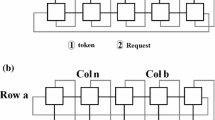Summary
A distributed system consists of a set of loosely connected machines that do not share a global memory. The system isself-stabilizing if it can be started in any global state and achieves consistency all by itself. This also means that the system can deal withinfrequent errors. This paper presents self-stabilizing multi-token rings. A multitoken ring is a generalization of a (one-)token ring. The algorithms presented are generalizations of a self-stabilizing mutual exclusion algorithm by Dijkstra [5] which can also be viewed as a token ring. We develop the algorithms in a stepwise manner, to show how and why we arrived at the final multi-token rings. The final parameterized algorithm represents a set of algorithms, one for each choice of the parameter. This enables one to select the algorithm with an optimal trade-off in desired flexibility versus memory requirements and stabilization time.
Similar content being viewed by others
References
Afek Y, Dolev D, Gafni E, Merritt M, Shavit N: A bounded first-in, first-enabled solution to the 1-exclusion problem. 4th International Workshop on distributed Algorithms, Bari, Italy, September 24–26. Lect Notes Comput Sci, vol 486. Springer, Berlin Heidelberg New York 1990, pp 422–431
Brown G, Gouda M, Wu M: Token systems that self-stabilize. IEEE Trans. Comput 38(6):845–852 (1989)
Burns J, Gouda M, Miller R: On relaxing interleaving assumptions. MCC Workshop on Self-Stabilization, Austin, Texas, November 1989
Burns J, Pachl J: Uniform self-stabilizing rings. ACM Trans Program Lang Syst 11(2):330–344 (1989)
Dijkstra EW: Self-stabilization in spite of distributed control. Commun ACM 17:643–644 (1974)
Dijkstra EW: Self-stabilization in spite of distributed control In: Selected writings on computing: a personal perspective. Springer, Berlin Heidelberg New York 1982, pp 41–46
Dolev D, Gafni E, Shavit N: Toward a non-atomic era:l-exclusion as a test case. 20th Annual ACM Symposium on Theory of Computing, Chicago, IL, May 2–4, 1988, pp 78–92
Dolev S, Israeli A, Moran S: Self-stabilization of dynamic systems assuming only read/write atomicity. 9th Annual ACM Symposium on Principles of Distributed Computing, Quebec City, Quebec, August 22–24, 1990, pp 103–118
Fischer M, Lynch N, Burns J, Borodin A: Resource allocation with immunity to limited process failure. 20th IEEE Symposium on Foundations of Computer Science, pp 234–254, 1979
Fischer M, Lynch N, Burns J, Borodin A: Distributed Fifo allocation of identical resources using small shared space. ACM Trans Program Lang Syst 11(1):90–114 (1989)
Flatebo M, Datta AK, Schoone AA: Self-stabilizingl-exclusion algorithms. Tech Rep RUU-CS-93-01, Dept of Computer Science, Utrecht University, Utrecht, 1993
Katz S, Perry KJ: Self-stabilizing extensions for message-passing systems. 9th Annual ACM Symposium on Principles of Distributed Computing, Quebec City, Quebec, August 1990, pp 91–101
Lin C, Simon J: Observing self-stabilization. 11th Annual ACM Symposium on Principles of Distributed Computing Vancouver, Canada, August 1992, pp 113–123
Peterson G: Observations on l-exclusion. 28th Annual Allerton Conference on Communication, Control, and Computing, Monticello, IL, October 3–5, 1990, pp 568–577
Author information
Authors and Affiliations
Additional information
Mitchell Flatebo received the B.S. degree in Mathematics (1990), the B.S. degree in Computer Science (1990), the M.S. degree in Mathematics (1992), and the M.S. degree in Computer Science (1993) from the University of Nevada, Las Vegas. He is currently a software engineer for Loral Space and Range Systems. His research interests include distributed systems, fault-tolerant computing, and self-stabilization.
Ajoy Kumar Datta received the Ph.D. degree in Computer Science from the Jadavpur University, Calcutta, India in 1983. He is currently an Associate Professor of Computer Science at the University of Nevada, Las Vegas. His area of research is distributed and fault-tolerant computing —algorithms and self-stabilization.
Anneke Schoone received an M.Sc. degree in Biology in 1978, an M.Sc. degree in Mathematics in 1981, and a Ph.D. degree in Computer Science in 1991 from Utrecht University (The Netherlands). Currently she is a senior research associate at the Department of Computer Science of Utrecht University, supported by ESPRIT Basic Research Action No. 7141 (project ALCOM II:Algorithms and Complexity) of the EC. Her research interests include assertional verification of distributed algorithms and the concept of self-stabilization.
The research of this author was supported partially by the ESPRIT Basic Research Action No. 7141 (project ALCOM II:Algorithms and Complexity), and partially by the Netherlands Organization for Scientific Research (NWO) under contract NF 62-376 (NFI project ALADDIN:Algorithmic Aspects of Parallel and Distributed Systems)
Rights and permissions
About this article
Cite this article
Flatebo, M., Datta, A.K. & Schoone, A.A. Self-stabilizing multi-token rings. Distrib Comput 8, 133–142 (1995). https://doi.org/10.1007/BF02242715
Received:
Accepted:
Issue Date:
DOI: https://doi.org/10.1007/BF02242715




